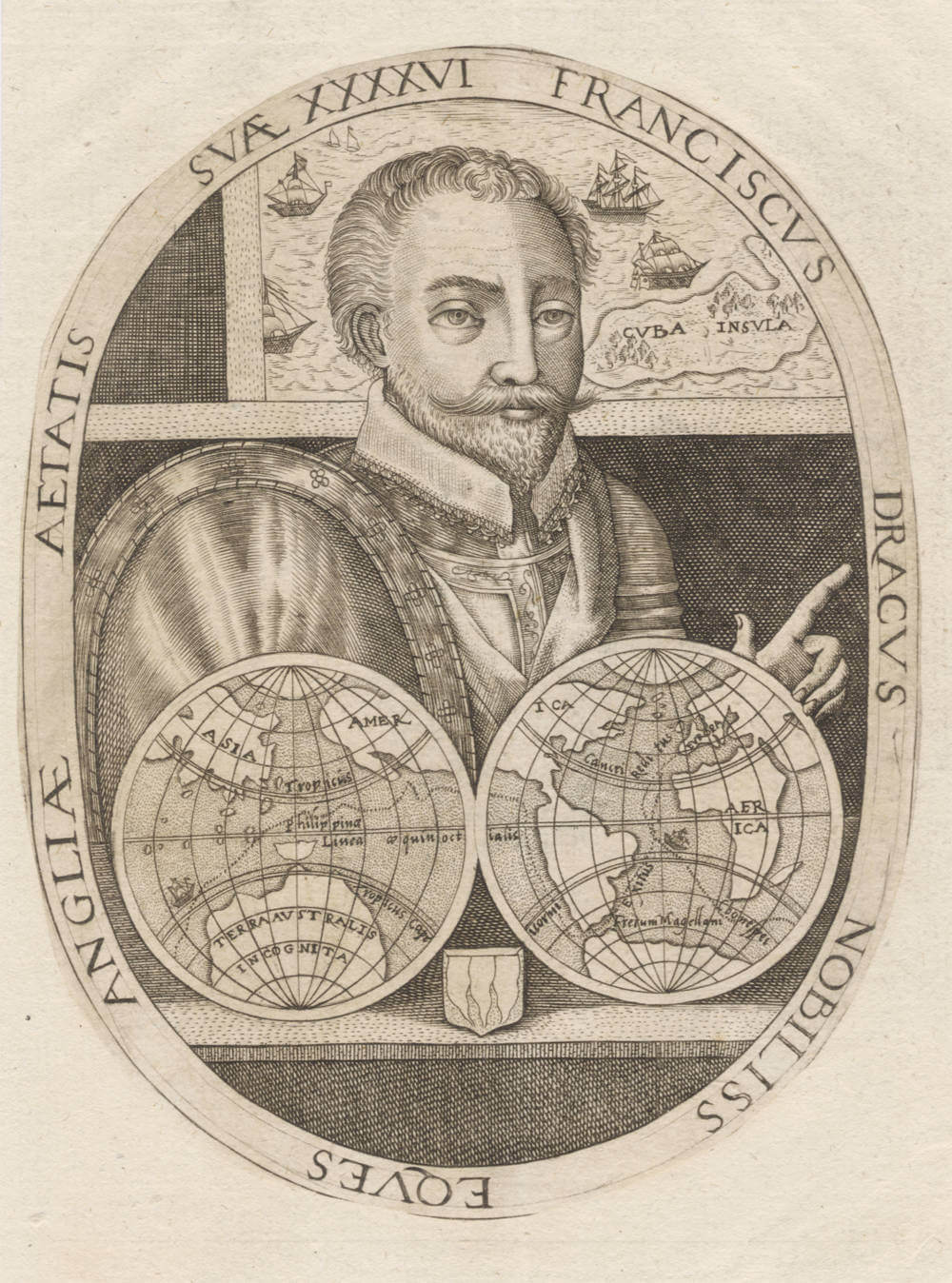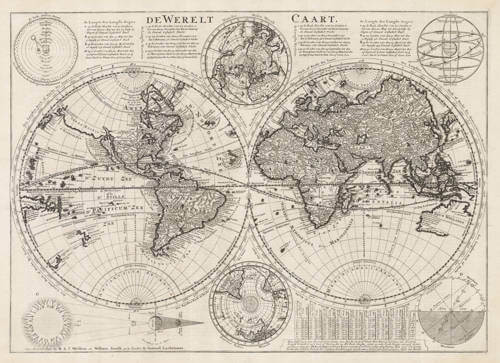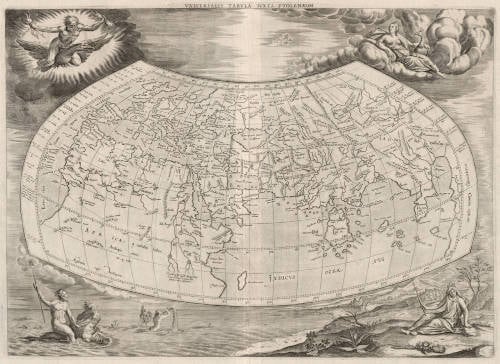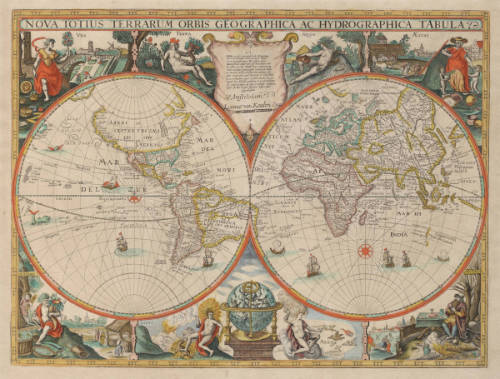Leen Helmink Antique Maps
Contemporary portrait of Sir Francis Drake with a map of the world and of Cuba.
The item below has been sold, but if you enter your email address we will notify you in case we have another example that is not yet listed or as soon as we receive another example.
Stock number: 19471
Zoom ImageCartographer(s)
Jodocus Hondius (biography)
Title
Franciscus Dracus Nobiliss Eques Angliae Aetatis Suae XXXXVI
First Published
Amsterdam, 1596
This Edition
1596 first and only edition
Size
16.4 x 12.5 cms
Technique
Condition
excellent
Price
This Item is Sold
Description
"the fabulously rare Drake portrait"
(John Carter Brown Library)
Franciscus Dracus Nobiliss Eques Angliae Aetatis Suae XXXXVI
Francis Drake, the most noble knight of England, at the age of 46.
Unobtainable half length portrait in oval frame of Sir Francis Drake (1540-1596), with two maps:
1- a double hemishere map of the world, being a reduced size copy of the legendary Jodocus Hondius-Francis Drake broadsheet map of the world (Vera Totius Expeditionis Nauticae) at the bottom, which was first engraved by Hondius in Amsterdam, circa 1595. The world map records the track of Drake's circumnavigation, and shows a large Terra Australis Incognitae. It also records Drake's landfall in the Philippines.
2- a map of Cuba, illustrating Drake final forey in the Caribbean where he would die of "the bloody flux" (dysentery) and was buried at sea in a sealed lead-lined coffin. The coffin has not yet been recovered, despite many attempts.
Only two copies of this portrait are known (John Carter Brown and British Museum).
Lacking in all other collections. Not in Shirley. Not in the LoC Kraus Drake collection. Not in Sir Francis Drake: A Pictorial Biography by Hans P. Kraus.
The portrait is modeled after an earlier Drake portrait by Jodocus Hondius, one that was used for his Drake map of the circumnavigation of the world. In the portrait here however, a map of Cuba is added.
The portrait is believed to have been made for an excruciatingly rare 1596 news pamphlet to commemorate the life and death earlier that year of Sir Francis Drake, with title:
Franciscus Dracus redivivus | Das ist, | Kurtze Beschreibung , al- | ler vornehmbsten Reysen , Schiffarten |
unnd Wasserschlachten , So der weîtberûmbte En- | glische Admiral, Franciscus Dracus , welcher inn zwey | Jahren und zehen Monaten orbem Mundi beschiffet, hin vnd wider | bey Pleymeuten , Carthag: S. Domingo. August : Florida und der | Insul Cuba, in seinem Leben glûcklich gehalten | und vollbracht. | Item von der jetzigen Engelischen Admiraln unnd | Schiffobersten bey Calis Malis verrichten und Abzug, und was sie | noch weiter daselbsten herumb bîsz Dato . vor- | haben , &c. | Alles in drey Kupfferstuck ordentlich vorgebîldet, und durch Zifferm erklaret, &c. |
(Coat of arms of England between the date 1596) | Erstlich Getruckt zu Amstertamb in Holland, | durch Johann Clausen. | 4^o.
That important pamphlet has only survived in three or four copies (John Carter Brown, Berlin, Erfurt). As pointed out by Tiele (Mémoire bibliographique sur les journaux des navigateurs néerlandais, 1867) the title calls for three copperplates ("drey Kupfferstuck"), but those were missing in the known copies of the pamphlet.
John Carter Brown managed to complete one copy with the missing copperplates. In their annual report of 1927 (page 5) they write:
The acquisition of books continues to be the adventure that the collecting of treasure has always been to those who give themselves to that thrilling employment. Just when it seems that everything worth while has been secured or has become no longer available for purchase, one of our friends among the booksellers turns up something of unusual interest. Or, when we have despaired of finding a much desired item - for example the fabulously rare Drake portrait needed for the Franciscus Dracus Redivivus, printed in German in 1596 - a Parisian printseller appears on a casual visit and when facetiously questioned, reaches into his portfolio and answers the wild surmise in our eyes by drawing out the one print in all the world most essential to our happiness at that moment. The portrait was from the print collection of Louis Philippe, and the printseller, properly rewarded, is now searching for the Cavendish portrait, the Grosse Insel Cuba map and the Armada print needed to make our copy of the book, a great rarity in itself, the only one known to possess its plates besides that in the British Museum.
Condition
A crisp and even imprint of the copperplate. Cut to the border and pasted onto another contemporary sheet of paper, like the two other known copies. A very desirable example of a seminal unobtainable item that makes a difference for any collection of Drake, Pacific or circumnavigation.
Jodocus Hondius (1563-1612)
Jodocus Hondius the Younger (son) (1594-1629)
Henricus Hondius (son) (1597-1651)
Jodocus Hondius the Elder, one of the most notable engravers of his time, is known for his work in association with many of the cartographers and publishers prominent at the end of the sixteenth and the beginning of the seventeenth century.
A native of Flanders, he grew up in Ghent, apprenticed as an instrument and globe maker and map engraver. In 1584, to escape the religious troubles sweeping the Low Countries at that time, he fled to London where he spent some years before finally settling in Amsterdam about 1593. In the London period he came into contact with the leading scientists and geographers of the day and engraved maps in The Mariner's Mirrour, the English edition of Waghenaer's Sea Atlas, as well as others with Pieter van den Keere, his brother-in-law. No doubt his temporary exile in London stood him in good stead, earning him an international reputation, for it could have been no accident that Speed chose Hondius to engrave the plates for the maps in The Theatre of the Empire of Great Britaine in the years between 1605 and 1610.
In 1604 Hondius bought the plates of Mercator's Atlas which, in spite of its excellence, had not competed successfully with the continuing demand for the Ortelius Theatrum Orbis Terrarum. To meet this competition Hondius added about 40 maps to Mercator's original number and from 1606 published enlarged editions in many languages, still under Mercator's name but with his own name as publisher. These atlases have become known as the Mercator/ Hondius series. The following year the maps were re-engraved in miniature form and issued as a pocket Atlas Minor.
After the death of Jodocus Hondius the Elder in 1612, work on the two atlases, folio and miniature, was carried on by his widow and sons, Jodocus II and Henricus, and eventually in conjunction with Jan Jansson in Amsterdam. In all, from 1606 onwards, nearly 50 editions with increasing numbers of maps with texts in the main European languages were printed.
(Moreland and Bannister)
Related Categories
Antique maps of the World
Old Master Prints
Antique maps of the British Isles
Antique maps of Australia
Antique maps of the Philippines
Antique maps of Asia
Antique maps of the United States
Antique maps of South America
Antique maps of Central America
Antique maps of America
Antique maps of Africa
Old books, maps and prints by Jodocus Hondius
Related Items






